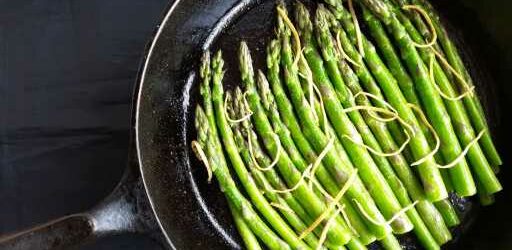We eat our seasons, don’t we? In winter, warming soups, stews and such. Cool and cooling foods come summer, such as ice cream of course, and salads and foods grilled, shooing outside the kitchen’s heat.
Spring means asparagus and asparagus means spring. At the grocer’s, truly fresh asparagus appears still to be growing. Any spearhead unknotting, any shaft withering, any cut end shriveling — we shun such, knowing that its nutty, sweet, grassy flavor to be much diminished, its crisp texture uncrunched, its character unsprung, “un-springed.”
The diameter of asparagus signifies nothing other than the age of its mother crown, hidden below the surface of its protective and fecund soil and birthing its spears each year. If it is a young crown, the spears will be thin; if older, thicker.
All fresh asparagus, thick or thin, tastes the same. Thicker spears may have a more fibrous peel and, so, may benefit from a peeling of their lower half. But that’s not always so. Treat each spear after getting to know it. Even thin spears might benefit from peeling, or thick be at their best from being left alone.
The adage to “snap an asparagus spear where it naturally breaks” wastes an enormous amount of vegetable. It breaks where you place your fingers. You need to excise merely an inch or slightly more from the end, using a sharp knife blade, making uniform in length all the spears, both to ease your cooking and to please your diners’ eyes.
Refrigerate trimmed spears of asparagus in at least 2 inches of water, placed inside a large-mouthed jar or container, everything covered with a snapped-on shower cap. They will keep like that for a week because they truly are like cut flowers. Yet you will wish to eat them well before they wither.
Always wash fresh spears of asparagus in a couple of changes of cool or cold water. Like leeks and some celery — and all cilantro, it forever seems — asparagus picks up grit as it pushes itself toward the sun and out of its bed of soil. The tips (especially if not as tightly closed as a child’s fist on candy) and the bracts along its shaft may harbor fine and not easily seen sand.
You may boil, broil, blanch, braise, steam, stir-fry, grill, roast or eat raw most asparagus and each method has its partisans. Cooking times depend on method, but thin spears rarely take more than three minutes to cook through, swimming in or cooking over any sort of heat. Thicker spears, a couple of minutes more but only.
Butter bathes it best, sparked by something acidic such as lemon. This is why unsalted cultured butter, with its ever-so-slight yogurty tang, is the better butter of the best.
Eggs quite take to it, especially eggs with runny yolks. Ham helps. It bakes well and is puréed successfully as a major flavor to a soup, warm or tepid in temperature.
The recipes here bring out the best of asparagus. In her seminal “The Taste of Country Cooking,” Edna Lewis is a minimalist cook of it, not even shaving the ends. My mother, Madeleine St. John, also treated it plainly in the recipe from her cooking school La Bonne Cuisine (sadly gone). Lemon, in two forms, edges it like a picture frame.
Happy Mother’s Day, by the way, to all cooking moms, mothers and motherly or mothering cooks. Asparagus is truly your centerpiece vegetable, for it appears at its best at that time of year of your special day.
Skillet Asparagus
From Edna Lewis at saveur.com, adapted from her book “The Taste of Country Cooking.” Serves 4-6.
Ingredients
- 2 tablespoons unsalted butter
- 2 pounds asparagus, fibrous bottoms cut off
- Kosher salt and freshly ground black pepper
Directions
In a large skillet set over medium heat, melt the butter. When the foam subsides, add the asparagus and shake the pan to coat the spears. Cover and cook, shaking occasionally, until bright green but still crisp, about 3 minutes.
Uncover and continue cooking until the asparagus is tender when pierced with the tip of a knife, 5-10 minutes more (the thicker the spears, the longer the cook time). Season to taste with salt and black pepper.
Asparagus Spears with Lemon Dressing
From Madeleine St. John, La Bonne Cuisine Cooking School, Denver. Serves 4.
Ingredients
- 24 slender asparagus spears
- 4 large leaves Romaine lettuce
- For the lemon dressing:
- 1 1/2 tablespoons olive oil
- 1 1/2 tablespoons fresh lemon juice
- 1 tablespoon water
- For the garnish:
- 8 thin julienne strips lemon rind
Directions
Cut off the asparagus about 3 inches below the tips. (Reserve the bottoms to use for stock.) Cook the spears in 3 quarts boiling water for 5 minutes. When cooked, immediately plunge them into very cold or ice water and leave to cool down. Drain them, wrap in paper toweling and refrigerate. (This crisps them up.)
To serve, place a lettuce leaf on each of 4 chilled plates and arrange 6 asparagus spears over each leaf. Combine the dressing ingredients in a cup, blending well with a fork and drizzle about 1 tablespoon dressing over each serving. Decorate with the lemon rind strips.
Subscribe to our weekly newsletter, In The Know, to get entertainment news sent straight to your inbox.
Source: Read Full Article



